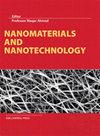Influence of silver electrochemically deposited onto zinc oxide seed nanoparticles on the photoelectrochemical performance of zinc oxide nanorod films
IF 3.3
3区 材料科学
Q2 MATERIALS SCIENCE, MULTIDISCIPLINARY
引用次数: 6
Abstract
The present article examines the synthesis and characterization of zinc oxide nanorods grown on zinc oxide and silver nanoparticle seeds. Zinc oxide seeds were electrodeposited on a support of fluorine-doped tin oxide glass and heat-treated at 380°C. Silver nanoparticles were then deposited on this substrate, which was heat-treated at 160°C. Their presence was confirmed using ultraviolet–visible spectroscopy, by observing an absorption peak around 400 nm, corresponding to surface plasmon resonance. Growth of zinc oxide nanorods was achieved in a chemical bath at 90°C. The obtained films were analyzed by cyclic voltammetry, X-ray diffraction, and scanning electron microscopy. They consisted of zinc oxide with a Wurtzite-type crystal structure, arranged as nanorods of 50 nm. X-ray photoelectron spectroscopy exhibits peaks attributed to silver (0) and to the formation of silver oxide on the silver nanoparticle surface. In addition, two types of oxygen (O 1 s) were observed: oxygen from the crystalline network (O–2) and chemisorbed oxygen (–OH), for the seed and the nanorod films, respectively. The nanorods grown on zinc oxide seeds with silver deposits had a round shape and greater photoactivity than those grown without silver. This difference is attributed to the additional reflection that silver provides to the light reaching the film, thereby increasing the photogeneration from the charge carriers.电化学沉积银对氧化锌纳米棒薄膜光电化学性能的影响
本文研究了在氧化锌和银纳米粒子种子上生长的氧化锌纳米棒的合成和表征。将氧化锌籽晶电沉积在掺氟氧化锡玻璃的载体上,并在380°C下进行热处理。然后将银纳米颗粒沉积在该基底上,该基底在160°C下进行热处理。通过观察400 nm附近的吸收峰,使用紫外-可见光谱法确认了它们的存在,该吸收峰对应于表面等离子体共振。氧化锌纳米棒的生长是在90°C的化学浴中实现的。通过循环伏安法、X射线衍射和扫描电子显微镜对所获得的薄膜进行分析。它们由具有纤锌矿型晶体结构的氧化锌组成,排列为50nm的纳米棒。X射线光电子能谱显示出归因于银(0)和银纳米粒子表面上氧化银形成的峰。此外,观察到两种类型的氧(O1s):来自晶体网络的氧(O2)和化学吸附的氧(-OH),分别用于种子膜和纳米棒膜。在具有银沉积物的氧化锌种子上生长的纳米棒具有圆形形状,并且比没有银的生长的纳米棒具有更大的光活性。这种差异归因于银对到达薄膜的光提供的额外反射,从而增加了电荷载流子的光生。
本文章由计算机程序翻译,如有差异,请以英文原文为准。
求助全文
约1分钟内获得全文
求助全文
来源期刊

Nanomaterials and Nanotechnology
NANOSCIENCE & NANOTECHNOLOGY-MATERIALS SCIENCE, MULTIDISCIPLINARY
CiteScore
7.20
自引率
21.60%
发文量
13
审稿时长
15 weeks
期刊介绍:
Nanomaterials and Nanotechnology is a JCR ranked, peer-reviewed open access journal addressed to a cross-disciplinary readership including scientists, researchers and professionals in both academia and industry with an interest in nanoscience and nanotechnology. The scope comprises (but is not limited to) the fundamental aspects and applications of nanoscience and nanotechnology
 求助内容:
求助内容: 应助结果提醒方式:
应助结果提醒方式:


